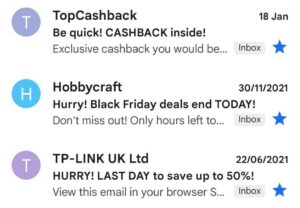

The subject lines that’ll convert every single time

… don’t exist. Sorry about that. BUT, clickbait subject lines do exist. (See what I did there?)
Subject lines are hugely important. After putting lots of time and effort into your campaign, you want it to be opened. With just your sender name and subject line visible in the inbox, you need to nail it. It can be tempting to resort to any tactics necessary to get that open, which you hope will become the first step in a conversion, but if you get this wrong you could do more damage than a non-open. So, let’s explore clickbait subject lines and discuss their place in an inbox.
What is clickbait?
Clickbait works by creating curiosity; sensationalist phrases make you desperate to know more. The human brain reacts to new information with pleasure, a hit of dopamine means that the interaction makes you feel good. Clickbait plays on this human desire to know more, it creates an itch – whether that’s a headline, an online ad, or a subject line – that you can only ‘scratch’ by clicking. But, what does it actually achieve?
We all know that opens aren’t a reliable, or viable (thanks Apple), metric these days. So the idea of opens alone is a non-starter. You need to be measuring it against engagement such as clicks, conversions and replies. I guess to understand if a clickbait subject line would work for this, we need to break it down a bit. There are a few different types after all.
Types of clickbait subject lines
The FOMO effect
Let’s start with my least favorite. FOMO, the ‘fear of missing out’ is a thing, and brands can sometimes play on this to get you to click. Creating a sense of urgency to encourage you to click, or you’re going to miss out on something. Of course urgency is a legitimate tactic, and certainly has it’s place – think flash sales, limited stock notifications etc. However, I detest emails with subject lines full of multiple exclamation marks, peppered with words such as ‘quick’, ‘hurry’, and ‘ASAP’ – and don’t get me started on subject lines made up of all capital letters (which is a spam trap too).

I don’t want to feel like my inbox is shouting at me. Emails should serve you, not stress you out. Creating a sense of urgency is one thing, creating stress is another.
By tapping into your customer’s fear of missing out (FOMO), you can be sure to get a lot of opens, but it’s not something you should overdo. Unlike online websites which rely on a large volume of clicks to make money through placed adverts, a brand’s relationship with its customers is built on more than a quick fling. We’re building, hopefully, long-lasting relationships with our customers and to do that you need to respect them and value their time.
If you’re always pushing a ‘last chance’ message, people will get desensitized to it and you’ll find yourself struggling to get engagement. By all means convey urgency where there is some, but manufacturing urgency and sensationalizing your offering is only going to damage the trust between your brand and your customers, and lead to a higher churn rate.
Oops! Sorry not sorry
On a similar vein to this, we have the fake apology subject lines. Humans are a naturally curious bunch, we see an apology subject line and we are eager to see what went wrong, and if we are getting something free as a result.
Some brands have recognized that this style of subject line gets a huge engagement rate and have then capitalized on it. Think ‘We’re sorry.’ *opens email* ‘That you didn’t shop in our sale, here’s a discount code’. I get it, we see something working, we need to make it work harder. That’s marketing. Who am I to begrudge anyone of finding an engagement tactic that performs.

But the key thing here is consistency. Ever heard the tale of the boy who cried wolf? Utilizing tactics like this now and then isn’t going to do too much harm, but overusing it could leave you in a sticky situation when the time comes for you to send out a legitimate apology email, and no one opens it.
Once again, you need to ensure you’re towing the line between engagement, having fresh and inviting subject lines, and going too far, resulting in your customers switching off when they see an email marketing campaign from your brand. Inboxes are crowded places, and wanting to stand out is absolutely the goal, but you need to ensure that your subject line and the content inside it is matching up. Trust is so important, especially when brand loyalty is at an all time low, be sure to respect your audience and serve them subject lines which pique their interest, without being misleading.
Transactional trickery
We all know transactional emails perform really well. Everyone wants to track their purchase after all. I recently received an email from a brand I usually love, with the subject line: ‘Thank you for your order.’ I’ll be honest, it made me panic for a moment. I was sure I hadn’t made an order, but it made me doubt myself. I clicked on the email to find, not an order confirmation, but a generic thank you for being a customer message with a discount code encouraging me to place an order. It was a nice idea, and I can understand the thinking behind it, but as a customer, I must admit that I did begrudge the trickery behind it.
I also received an email recently from a company I had shopped with saying: ‘Congratulations! You have been selected’ (you can probably see where this is going). It was an invitation, not to a swanky event, but to do a survey for them. By phrasing it as something exclusive, that I, personally, was able to do made it feel exciting. For about 2 seconds.
As a marketer, I love the spin on the traditional ‘we’d love your opinion’ survey request email. But as a customer, I didn’t love it, and I was a little disappointed. I didn’t leave a review, whereas if they’d gone down the honesty route of ‘your feedback is valuable to us’ I’d most likely have obliged.
In conclusion
Ultimately, while these tactics have some clear benefits, you need to be careful and use these tactics sparingly, so that rather than being clickbait-y, they’re seen as humorous and tongue-in-cheek.
It’s all about driving engagement without harming trust. Of course, to stand out in a crowded inbox we need to think outside of the box, but variety is key too. There are lots of different types of subject lines out there, humor, question-led, inspirational… the inbox is your oyster. Just be sure that you’re not purposefully misleading your audience with a sensationalist subject line that doesn’t match the content of your email.
As marketers we need to remember the humans at the other side of our communications. Sure, we absolutely should be strategizing, trying to push the boundaries, and hook that valuable engagement from our subscribers, but we don’t want to annoy them – nor can we afford to. Engagement is the goal, but so is retention and they needn’t cancel each other out. Building a rapport with customers, having a strong level of trust between your brand and your customers is far more valuable than an open, followed by an eye roll and, quite possibly, an unsubscribe.
Curiosity killed the cat, don’t let it kill your engagement too.
Contents
Natasha Lainsbury

Subject line tips and tricks
First impressions count, learn how to make a strong inbox impression with our cheatsheet including all the tips, tricks and tools you need to stand out.
Get your copyStay on top
Get the latest and greatest marketing insight delivered to you weekly
Your email address will be handled in accordance with our Privacy Policy. We gather data around email opens & clicks using standard technologies including clear gifs to help us monitor and improve our newsletter.

